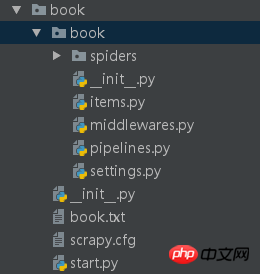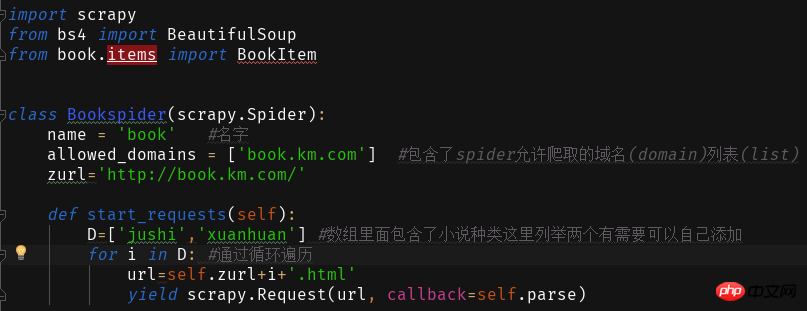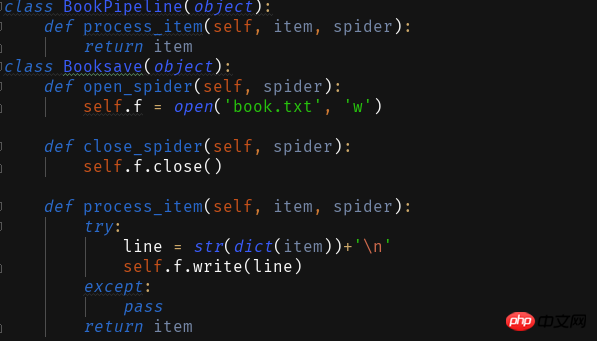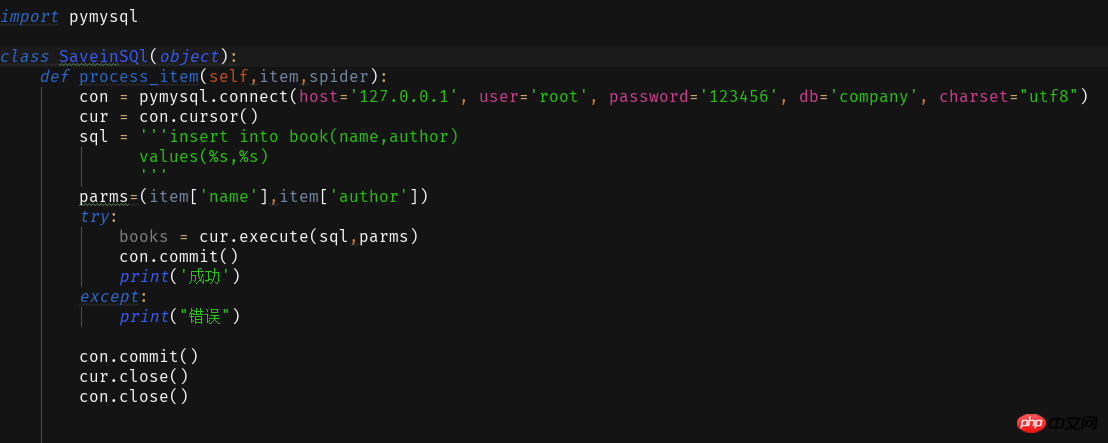Introduction to scrapy crawler framework
Introduce the scrapy crawler framework
Installation method pip install scrapy can be installed. I use the anaconda command to conda install scrapy.

1 Engine obtains the crawling request (Request) from Spider<br>2Engine will The crawling request is forwarded to Scheduler for scheduling
3 Engine obtains the next request to crawl from Scheduler<br>4 Engine sends the crawling request to Downloader through middleware<br>5 Crawl After the web page, the Downloader forms a response (Response) and sends it to the Engine through the middleware<br>6 The Engine sends the received response to the Spider through the middleware for processing. The Engine forwards the crawling request to the Scheduler for scheduling
7 After Spider processes the response, it generates scraped Item<br> and new crawling requests (Requests) to Engine<br>8 Engine sends the scraped item to Item Pipeline (framework exit)<br>9 Engine will The crawling request is sent to the Scheduler
Engine controls the data flow of each module and continuously obtains crawling requests from the Scheduler<br> until the request is empty<br>Frame entry: Spider's initial crawling request<br>Frame export: Item Pipeline
Engine Downloader<br>Download web pages according to requests<br>No user modification required<br>
SchedulerScheduling and management of all crawling requests<br>No user modification required<br>
Downloader MiddlewarePurpose: Implement user-configurable control between Engine, Scheduler and Downloader<br><br>Function: modify, discard, add request or response
User can write Configuration codeSpider<br><br>(1) Parse the response returned by Downloader<br>(2) Generate scraped item<br>(3) Generate Additional crawling requests (Request)
Require users to write configuration codeItem Pipelines<br><br>(1) Process the crawled items generated by Spider in a pipeline manner<br>( 2) It consists of a set of operation sequences, similar to a pipeline. Each operation <br> is an Item Pipeline type
(3) Possible operations include: cleaning, checking and duplication checking of theHTML data in the crawled items , Storing data into the databaseRequires users to write configuration code<br>After understanding the basic concepts, let’s start writing the first scrapy crawler. <br><br>First, create a new crawler project scrapy startproject xxx (project name) <br><br><br>
This crawler will simply crawl the title and author of a novel website. .
We have created the reptile project book now to edit his configuration

This is the introduction of the configuration file. Before modifying these
修 We now create a start.py in the first -level Book directory to use it for the Scrapy reptile to run in the IDE
## noodles. Write the following code in the file. The first two parameters are fixed, and the third parameter is the name of your spider
The first two parameters are fixed, and the third parameter is the name of your spider
Next we fill in the fields in items:

By clicking on the different types of novels on the website, you will find that the website address is +Novel Type Pinyin.html
Through this we write and read the content of the web page




<span style="color: #000000">ITEM_PIPELINES = { 'book.pipelines.xxx': 300,}<br>xxx为存储方法的类名,想用什么方法存储就改成那个名字就好运行结果没什么看头就略了<br>第一个爬虫框架就这样啦期末忙没时间继续完善这个爬虫之后有时间将这个爬虫完善成把小说内容等一起爬下来的程序再来分享一波。<br>附一个book的完整代码:<br></span>import scrapyfrom bs4 import BeautifulSoupfrom book.items import BookItemclass Bookspider(scrapy.Spider):
name = 'book' #名字
allowed_domains = ['book.km.com'] #包含了spider允许爬取的域名(domain)列表(list)
zurl=''def start_requests(self):
D=['jushi','xuanhuan'] #数组里面包含了小说种类这里列举两个有需要可以自己添加for i in D: #通过循环遍历
url=self.zurl+i+'.html'yield scrapy.Request(url, callback=self.parse)
def parse(self, response):
imf=BeautifulSoup(response.text,'lxml')
b=imf.find_all('dl',class_='info')for i in b:
bookname=i.a.stringauthor = i.dd.span.stringitem = BookItem()
item['name'] = bookname
item['author'] = authoryield item<br>
The above is the detailed content of Introduction to scrapy crawler framework. For more information, please follow other related articles on the PHP Chinese website!

Hot AI Tools

Undresser.AI Undress
AI-powered app for creating realistic nude photos

AI Clothes Remover
Online AI tool for removing clothes from photos.

Undress AI Tool
Undress images for free

Clothoff.io
AI clothes remover

AI Hentai Generator
Generate AI Hentai for free.

Hot Article

Hot Tools

Notepad++7.3.1
Easy-to-use and free code editor

SublimeText3 Chinese version
Chinese version, very easy to use

Zend Studio 13.0.1
Powerful PHP integrated development environment

Dreamweaver CS6
Visual web development tools

SublimeText3 Mac version
God-level code editing software (SublimeText3)

Hot Topics
 How to solve the permissions problem encountered when viewing Python version in Linux terminal?
Apr 01, 2025 pm 05:09 PM
How to solve the permissions problem encountered when viewing Python version in Linux terminal?
Apr 01, 2025 pm 05:09 PM
Solution to permission issues when viewing Python version in Linux terminal When you try to view Python version in Linux terminal, enter python...
 How to efficiently copy the entire column of one DataFrame into another DataFrame with different structures in Python?
Apr 01, 2025 pm 11:15 PM
How to efficiently copy the entire column of one DataFrame into another DataFrame with different structures in Python?
Apr 01, 2025 pm 11:15 PM
When using Python's pandas library, how to copy whole columns between two DataFrames with different structures is a common problem. Suppose we have two Dats...
 Python hourglass graph drawing: How to avoid variable undefined errors?
Apr 01, 2025 pm 06:27 PM
Python hourglass graph drawing: How to avoid variable undefined errors?
Apr 01, 2025 pm 06:27 PM
Getting started with Python: Hourglass Graphic Drawing and Input Verification This article will solve the variable definition problem encountered by a Python novice in the hourglass Graphic Drawing Program. Code...
 Python Cross-platform Desktop Application Development: Which GUI Library is the best for you?
Apr 01, 2025 pm 05:24 PM
Python Cross-platform Desktop Application Development: Which GUI Library is the best for you?
Apr 01, 2025 pm 05:24 PM
Choice of Python Cross-platform desktop application development library Many Python developers want to develop desktop applications that can run on both Windows and Linux systems...
 Do Google and AWS provide public PyPI image sources?
Apr 01, 2025 pm 05:15 PM
Do Google and AWS provide public PyPI image sources?
Apr 01, 2025 pm 05:15 PM
Many developers rely on PyPI (PythonPackageIndex)...
 How to efficiently count and sort large product data sets in Python?
Apr 01, 2025 pm 08:03 PM
How to efficiently count and sort large product data sets in Python?
Apr 01, 2025 pm 08:03 PM
Data Conversion and Statistics: Efficient Processing of Large Data Sets This article will introduce in detail how to convert a data list containing product information to another containing...
 How to optimize processing of high-resolution images in Python to find precise white circular areas?
Apr 01, 2025 pm 06:12 PM
How to optimize processing of high-resolution images in Python to find precise white circular areas?
Apr 01, 2025 pm 06:12 PM
How to handle high resolution images in Python to find white areas? Processing a high-resolution picture of 9000x7000 pixels, how to accurately find two of the picture...
 How to solve the problem of file name encoding when connecting to FTP server in Python?
Apr 01, 2025 pm 06:21 PM
How to solve the problem of file name encoding when connecting to FTP server in Python?
Apr 01, 2025 pm 06:21 PM
When using Python to connect to an FTP server, you may encounter encoding problems when obtaining files in the specified directory and downloading them, especially text on the FTP server...






